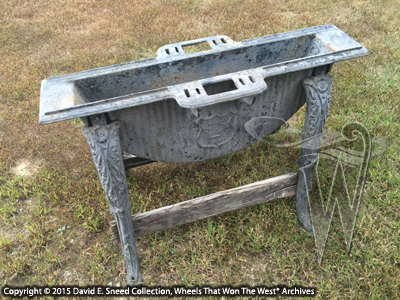Identifying old wagons, parts, and brands as well as related piecesfrom period blacksmith and woodworking shops can be interesting. There’s always some unique tool or vehiclefeature that tests our knowledge of what it took to design, build, repair, and operatethe wheels from America’s horse drawn era. Even though the road to discovery can be full of diversions and delays,sometimes it all comes together and a little effort pays off in dividends ofknowledge.
As an example – not long ago, I ran across a heavy, cast ironwhatchamacallit (I had no idea what it was) that sat on four ornately sculpted legs. The legs were set in pairs at each end of a narrow half-moon-shapedtrough that included a threaded drain hole in the bottom. The top of the trough flared out in themiddle with long slots that appeared to be positioned to help bolt somethingelse to it. As I surveyed the piece, Iwas told that it was a wheel soaker. Atfirst glance, I tended to agree but after studying it a bit more, I began towonder if that assessment was true. Thetrough looked too deep and the angle of the ends didn’t seem to exactly fit thecurvature of a wagon or buggy wheel.
 |
| Thissurviving framework was developed in the late 1860’s to hold a grindstone,making the tool more productive, efficient, and easier to operate. |
The other thing that was unusual was the ornate nature of thelegs. I’ve seen a lot of wheel soakersin all manner of sizes but none with such an extravagant support frame. There was a medallion in the shape of a Unionshield positioned on each of the longer sides of the trough. I could see that the shield was accompaniedby some words and numbers. Unfortunately, it was difficult to read because too many coats of painthad been applied over the years. Thepaint had filled in the openings of so many letters and numerals that a measureof patience was required to decipher it all.
 |
| These illustrations of an early grindstone frame are part of a patentawarded to Joseph Douglas on September 1, 1868. |
My wife and I spent nearly a half hour analyzing the lettering untilwe finally pieced together what was cast into the metal. It read, “W. & B. Douglas Middletown, Conn. Patented Sept. 1 1868.” After seeing an 1860’s timeframe attached tothis piece, I was determined to find out exactly what it was. A few quick queries into the U.S. Patentfiles and voila! We had it. As it turns out, this was not a wheel soakerat all. Although, it is something thatcould easily have been used in a blacksmith or carriage shop. Turns out, the cast iron piece is the basefor an early grindstone frame. In practice, the grinding wheel was fitted into the trough while side supports held it in place. The design was engineered to hold the wheel fast while allowing more control and easier,faster, more efficient use of the stone. The trough is a water chamber and the slotted upper flange was designedfor the inclusion of a tool guide/holder, wheel support, protective guards, aslip-resistant shaft, and the attachment of a treadle allowing for footoperation. Regrettably, some of theupper support structures were missing from the overall frame. At roughly a century and a half in age, thepiece we came across is certainly not something you see every day so it’sunderstandable that it could be misinterpreted as a wheel soaker.
Ultimately, that’s the very point that I wanted to make this week...that not everything is always as it first appears. Some of America's surviving wagons and early western vehicles are a hodge-podge of parts that have grown together over the years. As a result, looking only at one section, such as the name on the seat back or box side, does not always give us the whole story for proper identification and valuations. Many pieces can be mismatched. Taking the time to discern even minor differences not only helps provide a proper understanding of the piece but, it can mean all the difference in how well we choose and interpret early vehicles for a collection. Please Note: As with each of our blog writings, all imagery and text is copyrighted with All Rights Reserved. The material may not be broadcast, published, rewritten, or redistributed without prior written permission from David E. Sneed, Wheels That Won The West® Archives.
